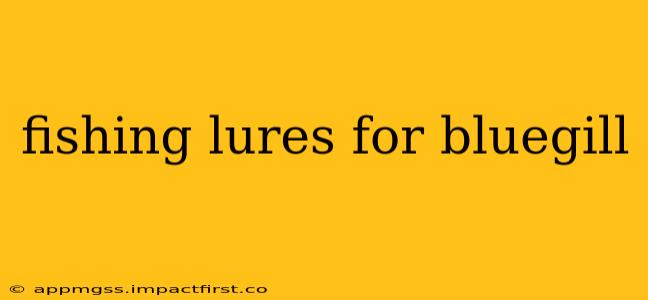Bluegill, with their vibrant colors and feisty nature, are a favorite target for anglers of all skill levels. But catching these sunfish requires understanding their feeding habits and choosing the right lure. This guide will delve into the best fishing lures for bluegill, covering various types, techniques, and considerations for a successful fishing trip.
What are the best lures for catching bluegill?
The best lures for bluegill often mimic their natural food sources: insects, crustaceans, and small fish. Success depends on factors like water clarity, time of year, and the specific bluegill's behavior. However, certain lure types consistently prove effective. These include:
-
Small Spinnerbaits: These lures, with their spinning blades, create vibrations and flashes that attract bluegill from a distance. Choose small spinnerbaits with lightweight blades (1/16 to 1/8 ounce) and brightly colored bodies (red, yellow, chartreuse).
-
Small Crankbaits: Crankbaits, with their diving action, can cover a lot of water. Select small, shallow-diving crankbaits (diving depth of 2-4 feet) in colors like natural shad patterns or bright, flashy colors.
-
Poppers: These topwater lures create a popping sound as they're retrieved, imitating insects struggling on the water's surface. Bluegill are readily attracted to this activity. Choose poppers in small sizes (1/4 to 1/2 inch) with bright or dark colors, depending on water conditions.
-
Soft Plastics: Small tubes, grubs, or worms in various sizes and colors are excellent choices. Rig them on lightweight jig heads (1/32 to 1/16 ounce) for optimal presentation. Natural colors such as green pumpkin, watermelon, and junebug are effective.
-
Small Jigs: These versatile lures can be fished in many ways, from slow dragging along the bottom to quick retrieves. Choose small jig heads (1/32 to 1/8 ounce) with small plastic trailers or even a small piece of worm.
-
Fly Fishing Lures: For the fly fisherman, small poppers, dry flies imitating insects, and nymphs are effective in attracting bluegill.
What color lures work best for bluegill?
Bluegill are attracted to a wide range of colors, and the best choice often depends on water clarity and light conditions. Bright colors like red, yellow, and chartreuse are generally effective in murky water, while more natural colors like green pumpkin and brown work well in clear water. Experimentation is key to finding the best color for a particular day and location.
What size lures are best for catching bluegill?
Bluegill generally feed on small prey, so using small lures is crucial. Lures ranging from 1/16 to 1/2 ounce are typically ideal. Oversized lures will often scare bluegill away.
What type of hooks should I use for bluegill fishing?
Use lightweight, sharp hooks, ideally in sizes 4 to 8. Lightweight hooks are less likely to scare away bluegill, and sharp hooks ensure a good hookset. Consider using barbless hooks to minimize injury to the fish if you plan on releasing them.
What are some good techniques for using lures to catch bluegill?
Effective techniques for using lures to catch bluegill vary depending on the lure type but generally involve slow and deliberate retrieves, punctuated by brief pauses. Experiment with different speeds and techniques to find what works best for a particular situation. Observe the bluegill's behavior to gauge their preferred presentation.
What's the best time of day to catch bluegill with lures?
Bluegill are most active during dawn and dusk, when they are actively feeding. However, they can be caught throughout the day, especially on overcast days or in shaded areas.
How do I choose the right lure for different water conditions?
In clear water, natural-colored lures will generally work best. In murky water, brighter, more visible colors are more effective. The depth of the water also plays a significant role. Choose lures that reach the depth where the bluegill are feeding.
By understanding bluegill behavior and employing the right lures and techniques, you'll significantly increase your chances of a successful fishing trip. Remember to always practice responsible angling and respect the environment.
